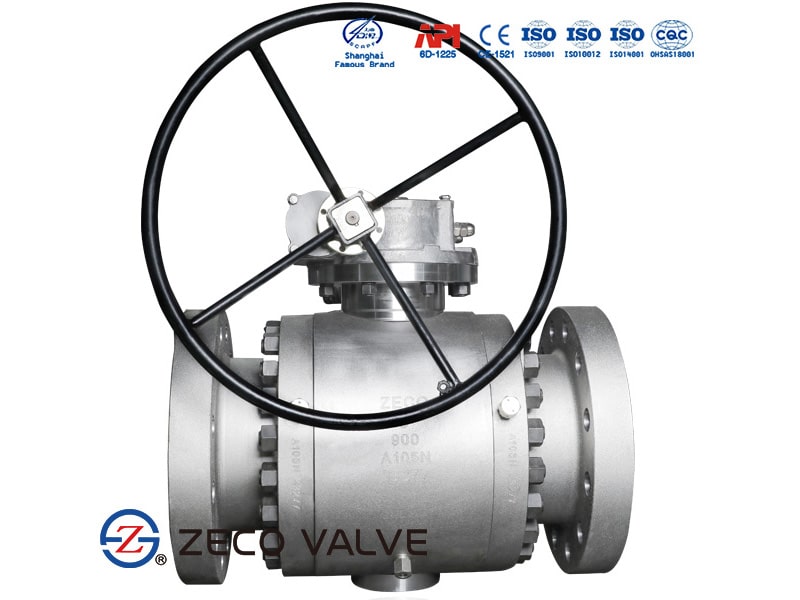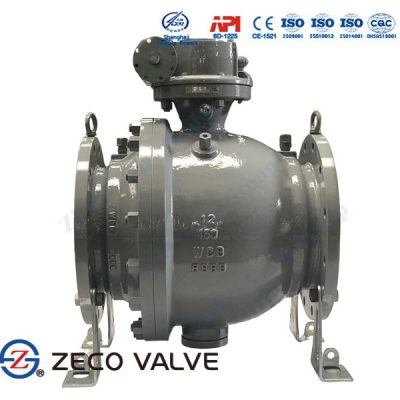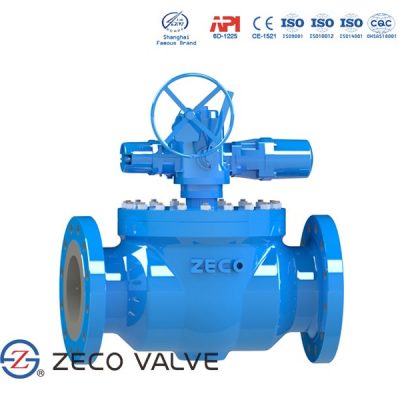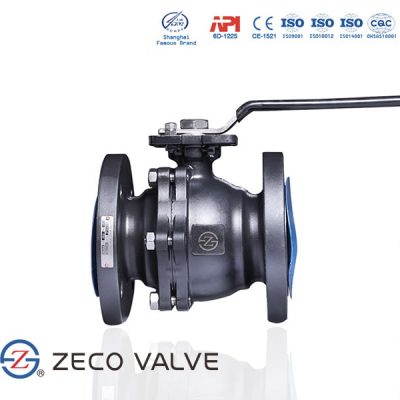Trunnion Ball Valve
Description
The trunnion ball valve is an essential device for regulating the flow of fluids- steam, gas, or oil in the pipeline.
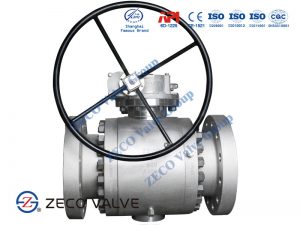
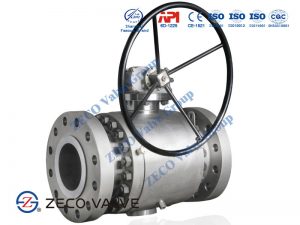
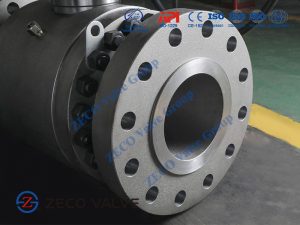
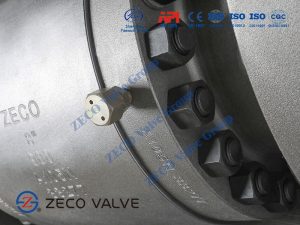
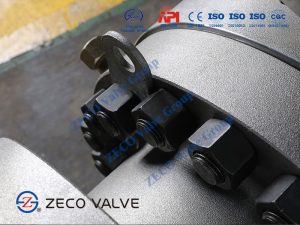
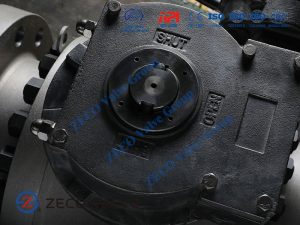
What is a Trunnion Ball Valve?
Trunnion mounted ball valves are quarter-turn valves used to stop the flow of medium in pipelines. These valves feature a round or spherical disk in the center that rotates to start or stop the flow. This disk is called a ball and it features a hollow center. Ball valves are extremely versatile and are commonly used in industrial applications where tight shut-off is required.
Trunnion mounted ball valves feature additional support for the ball. This support is in the shape of a shaft and is called a trunnion. The trunnion absorbs any added pressure from the flow, reducing stress on the ball and seats of the valve. Trunnion mounted ball valves are used in high-pressure, large-scale applications where low operating torque is required.
How does a Trunnion Ball Valve work?
Trunnion ball valves are quarter-turn valves. This means you need to turn the actuator on a 90-degree angle to turn the valve on or off. Once the actuator is turned the ball rotates so that the bore faces the pipeline and the medium can flow freely. Another turn of the handle moves the ball so that the bore faces away from the pipeline stopping the flow.
In a trunnion design, the ball is inserted in a central bottom shaft which is called the trunnion. The ball is fixed between the stem and the trunnion, which inclines that the ball is not floating but fixed and centered. The inline pressure presses the seats against the ball, causing tightness. This inclines that during operation, the ball does not have to be rotated against the in-line pressure (∆p) and the valve seats, but that it solely needs to be rotated against the pressure of the seats.

Types of Trunnion Ball Valves
Based on Body Structure
The valve body of a trunnion ball valve can have one or more pieces joined together through welded joints. There are two kinds of trunnion ball valves based on their number of pieces.
Two Piece Trunnion Ball Valve
This valve features two pieces of housing that are connected to each other through threaded connections. It is easy to open up one piece of housing to access the valve for cleaning or repair. However, the valve has to be disengaged from the pipeline before the housing can be removed.
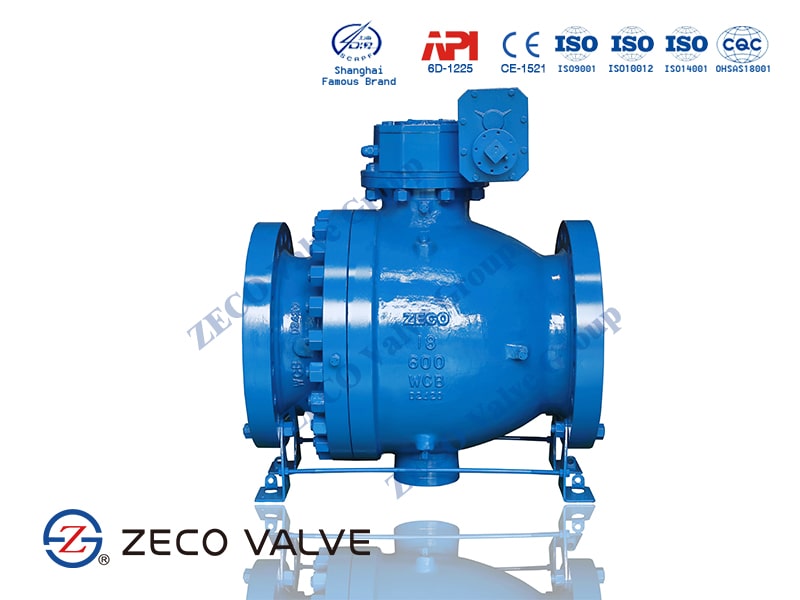
Three Piece Trunnion Ball valve
The three-piece trunnion ball valves are a step ahead of its two-piece version. They’ve got three bits of the casing that are bolted together. You should remove one section to access the inside of the valve for maintenance and repair. However, there is no need to disconnect the valve from its pipeline to remove it for maintenance.
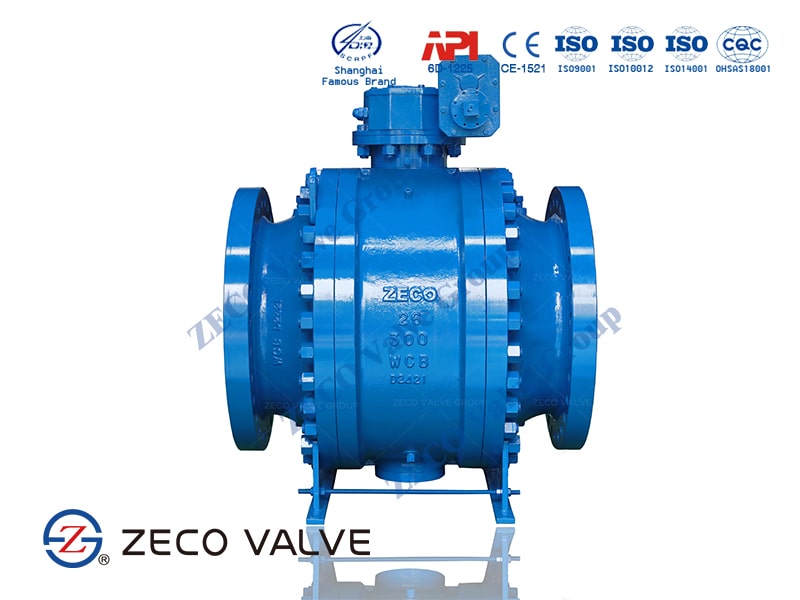
Based on Body Configuration
The body configuration features tell how a ball valve can be used and the ease of repairs and maintenance. Based on these parameters, three types of trunnion ball valves will be examined:
Top Entry Trunnion Ball Valve
This type of ball valve has a removable bonnet cover on the top of the valve. The internal parts of the valve can be easily accessed by removing the bonnet. These valves are easy to assemble and disassemble. You can repair or maintain different parts of the trunnion valve without removing them from the pipeline.
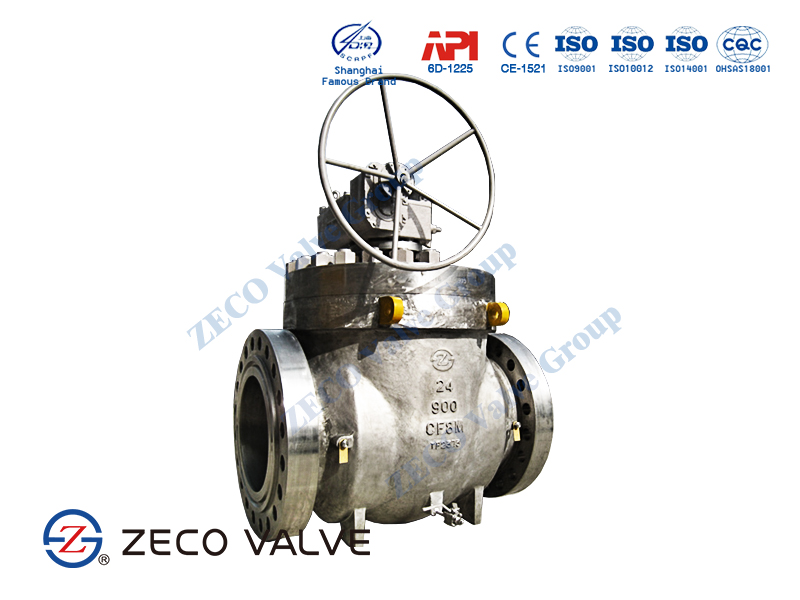
Side Entry Trunnion Ball Valve
This type of design is also referred to as the split body trunnion mounted ball valve. It assembles its ball from the side. They are often made out of forged metal. In this design, the body is often divided into three or two pieces that are joined together like extensions. A piece of the body is most often bigger than the rest of the design. This larger piece holds the stuffing that winds around the ball and the ball itself. For this design, they are easily repairable and can be inspected as the smaller piece can be pulled out to access the valve.
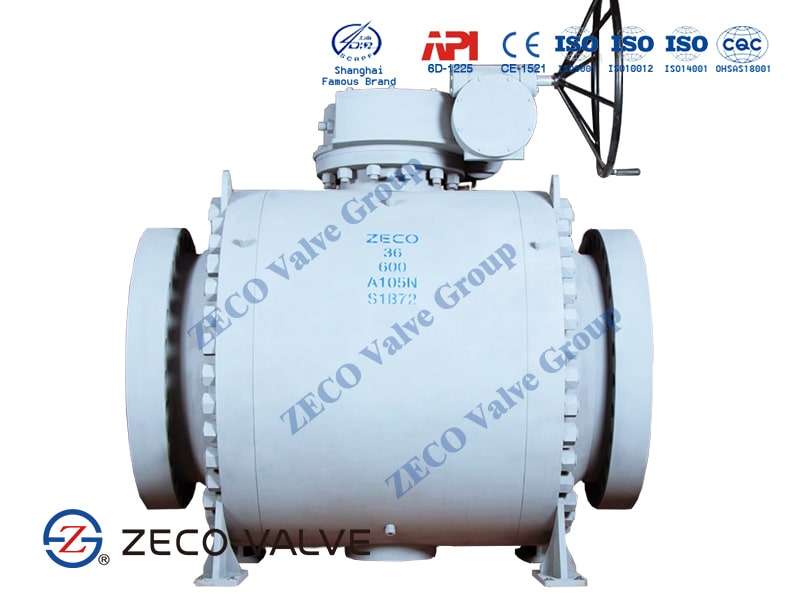
Based on Bores
A bore in a ball valve is the hole present in the ball’s center. There are two types of this design for trunnion ball valves based on bore size.
Full Bore Trunnion Ball Valve
In full bore valves, the size of the diameter of the bore matches that of the connected pipeline. When the valve is open, the medium can flow freely without restriction through the bore. This type of ball valve is used in chemical, petrochemical, and refining industries. They are also used in applications where pigging is required.
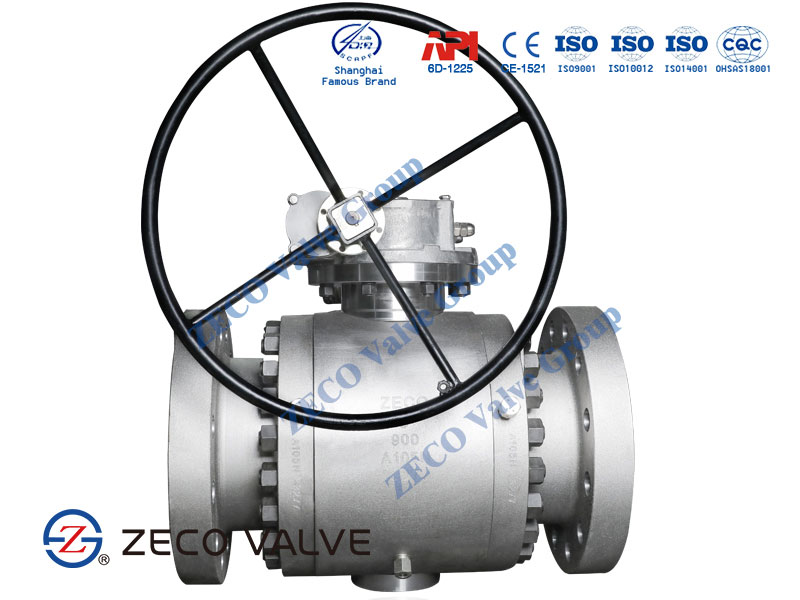
Reduced Bore Trunnion Ball Valve
A reduced bore valve is a design that has a bore size lesser than the connected pipeline’s diameter. The flow path of the channel is limited and results in greater energy loss. They are applicable to the gas and oil industry.
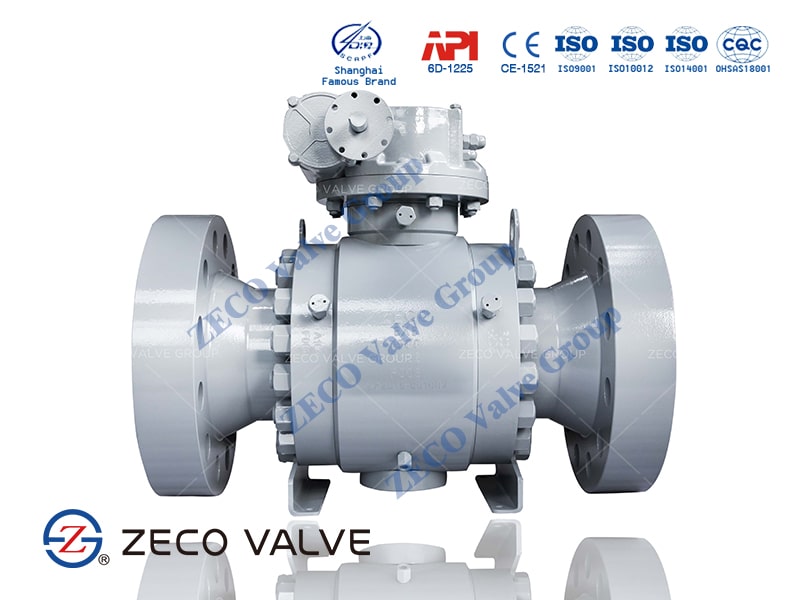
Applications of Trunnion Ball Valves
Oil and gas industries
Trunnion ball valves are perfect for a wide range of applications in several oil and gas industries. Examples of oil and gas industries that utilize trunnion ball valves include gas feed lines, field gas plants, industrial gas processing plants, oil refinery feedstock lines, and crude oil plants.
Pipeline industries
The ability of trunnion ball valves to handle several different applications such as gasses, slurries, and liquids makes them highly valuable in the pipeline industry.
Hydrocarbon industries
Because trunnion ball valves are useful for the facilitation of hydrocarbon processing, they are extremely popular among hydrocarbon industries.
Power Industries
Trunnion ball valves are suitable for numerous applications such as turbines, skids, generators, and compressors which are integral to the operation of power industries.
Chemical industries
Offering incredible safety, durability, and sealing capabilities, trunnion ball valves suit a wide variety of chemical industries where such competencies are imperative.
Features of Trunnion Ball Valves:
- EMERGENCY STEM SEALANT INJECTION: This standard feature allows the valve’s stem housing to be adapted with a grease fitting to inject sealant during emergency scenarios, providing protection against unplanned spikes in operating conditions.
- EMERGENCY SEAT SEALANT INJECTION: This optional feature allows the valve’s end connections to be adapted with a grease fitting to inject sealant. This creates a positive seal in the case of seat leakage due to service impurities or unplanned spikes in operating conditions.
- DRAIN AND VENT PORTS: Drain ports located at the bottom of the valve release any fluid trapped in the body cavity of a closed valve. Vent ports located at the top of the body cavity eliminate any gas trapped in the body cavity of a fully closed valve. Both play a key safety role in the double block and bleed and/or double isolation and bleed valve configurations.
- DOUBLE BLOCK AND BLEED: This safety feature eliminates the buildup of pressure due to high-pressure media trapped in the valve’s body cavity, even while the valve is in the fully closed position.
- FIRE SAFE DESIGN: Secondary metal seat design provides a fire-safe shut-off per API 607. Additionally, secondary graphite body seals and flexible graphite packing prevents leakage through the body joints and stuffing box, respectively.
- INTERNAL TRUNNION DESIGN: Upper and lower bearing plates hold the ball in place, preventing the ball from floating axially and avoiding excess load on the seats. External trunnion design is available in certain sizes.
- PRESSURE ENERGIZED STEM PACKING: Our proprietary energizer ring, located above the primary o-ring stem seal, provides insurance in the rare event that the O-ring is damaged by using the media pressure to create an upward compressive force on the packing. This upward force on the packing combined with the downward compressive force created by tightening the packing gland results in a larger net compressive force on the packing and a better seal than a typical packing design.
- DOUBLE SEALS ON BODY JOINTS: Primary elastomeric seals ensure zero leakage in standard operating conditions. Secondary graphite seals ensure proper body joint sealing per API 607 in extreme temperature scenarios.
- ANTI-STATIC DEVICES: Standard anti-static devices ensure electrical continuity between the ball, stem, and body, eliminating the possibility of sparks within the valve created by static electrical charges.
- VALVE POSITION INDICATION: Clear stamping on the outer diameter of the mounting flange identifies the open or closed position of the valve based on the stem key orientation.
- BLOWOUT-PROOF STEM DESIGN: Valves are designed with stem/body connection to prevent stem blowout under line pressure.
Product Overview of Trunnion Ball Valves
| SIZE RANGE | From 2” – 48” |
| PRESSURE RANGE | ANSI 150# – ANSI 2500# |
| MATERIAL GRADES | WCB, A105N, A182-F316 SS, A350-LF2, A350-LF6, and F51 Duplex |
| PORT SIZES | Full Bore, and Reduced Bore |
| TRIM MATERIALS | 3MIL ENP, 316SS, and F51 Duplex |
| SEAT INSERT MATERIAL | Devlon (PEEK and others available upon request) |
| SEAL MATERIALS | HNBR 90 DURO, James Walker 101/985, FKM GLT, and AFLAS |
| END CONFIGURATIONS | Raised Face (RF), Ring Type Joint (RTJ), Butt Weld (BW), and Flanged X Butt Weld |
| STANDARD FEATURES | Anti Static device; Anti Blowout Stem; Pressure relief valve to avoid cavity overpressure when applicable; Emergency built-in stem and seat sealant injection system; Fire Safe in accordance with API 607; MR-0175 NACE compliant; Fugitive Emissions compliant. |
| SEAT DESIGN FEATURES | Double Piston Effect, Self Relieving, Combination of options available |
| VALVE FUNCTIONALITY | Double Block and Bleed (DB&B), Double Isolation and Bleed (DIB-1 or DIB-2) |
| DESIGN STANDARDS | B16.34, B16.10, B16.5, B16.25, B16.47, Firesafe, Low Emissions Compliant, CSA Z245.15.2017 |

